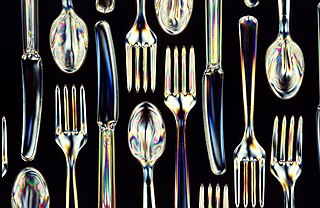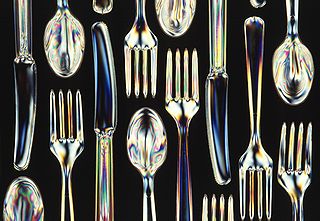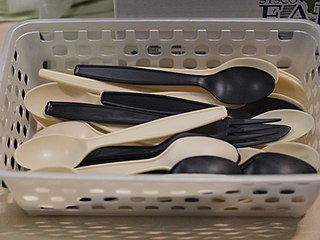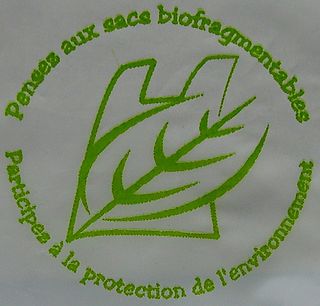
Plastic mulch is a product used, in a similar fashion to mulch, to suppress weeds and conserve water in crop production and landscaping. Certain plastic mulches also act as a barrier to keep methyl bromide, both a powerful fumigant and ozone depleter, in the soil. Crops grow through slits or holes in thin plastic sheeting. Plastic mulch is often used in conjunction with drip irrigation. Some research has been done using different colors of mulch to affect crop growth. This method is predominant in large-scale vegetable growing, with millions of acres cultivated under plastic mulch worldwide each year. Disposal of plastic mulch is cited as an environmental problem; however, technologies exist to provide for the recycling of used/disposed plastic mulch into viable plastic resins for re-use in the plastics manufacturing industry.
Polyhydroxybutyrate (PHB) is a polyhydroxyalkanoate (PHA), a polymer belonging to the polyesters class that area of interest as bio-derived and biodegradable plastics. The poly-3-hydroxybutyrate (P3HB) form of PHB is probably the most common type of polyhydroxyalkanoate, but other polymers of this class are produced by a variety of organisms: these include poly-4-hydroxybutyrate (P4HB), polyhydroxyvalerate (PHV), polyhydroxyhexanoate (PHH), polyhydroxyoctanoate (PHO) and their copolymers.

Plastic shopping bags, carrier bags, or plastic grocery bags are a type of plastic bag used as shopping bags and made from various kinds of plastic. In use by consumers worldwide since the 1960s, these bags are sometimes called single-use bags, referring to carrying items from a store to a home. However, reuse for storage or trash is common, and modern plastic shopping bags are increasingly recyclable or biodegradable. In recent decades, numerous countries have introduced legislation restricting the sale of plastic bags, in a bid to reduce littering and plastic pollution.

Bioplastics are plastics derived from renewable biomass sources, such as vegetable fats and oils, corn starch, straw, woodchips, food waste, etc. Bioplastic can be made from agricultural by-products and also from used plastic bottles and other containers using microorganisms. Common plastics, such as fossil-fuel plastics are derived from petroleum or natural gas. Not all bioplastics are biodegradable nor biodegrade more readily than commodity fossil-fuel derived plastics. Bioplastics are usually derived from sugar derivatives, including starch, cellulose, and lactic acid. As of 2014, bioplastics represented approximately 0.2% of the global polymer market.
Manuel Rendon is an Inventor and Engineer who created the first published formulation of degraded fossil-based high-density plastics.
Polyethylene or polythene film biodegrades naturally, albeit over a long period of time. Methods are available to make it more degradable under certain conditions of sunlight, moisture, oxygen, and composting and enhancement of biodegradation by reducing the hydrophobic polymer and increasing hydrophilic properties.

Biodegradable plastics are plastics that can be decomposed by the action of living organisms, usually bacteria.
Polymer engineering is generally an engineering field that designs, analyses, and modifies polymer materials. Polymer engineering covers aspects of the petrochemical industry, polymerization, structure and characterization of polymers, properties of polymers, compounding and processing of polymers and description of major polymers, structure property relations and applications.
PBAT is a biodegradable random copolymer, specifically a copolyester of adipic acid, 1,4-butanediol and terephthalic acid. PBAT is produced by many different manufacturers and may be known by the brand names ecoflex®, Wango,Ecoworld, Eastar Bio, and Origo-Bi. It is also called poly(butylene adipate-co-terephthalate) and sometimes polybutyrate-adipate-terephthalate or even just "polybutyrate". It is generally marketed as a fully biodegradable alternative to low-density polyethylene, having many similar properties including flexibility and resilience, allowing it to be used for many similar uses such as plastic bags and wraps. The structure of the PBAT polymer is shown to the right. It is depicted as a block co-polymer here due to the common synthetic method of first synthesizing two copolymer blocks and then combining them. However, it is important to note that the actual structure of the polymer is a random co-polymer of the blocks shown.

Biodegradable polymers are a special class of polymer that breaks down after its intended purpose by bacterial decomposition process to result in natural byproducts such as gases (CO2, N2), water, biomass, and inorganic salts. These polymers are found both naturally and synthetically made, and largely consist of ester, amide, and ether functional groups. Their properties and breakdown mechanism are determined by their exact structure. These polymers are often synthesized by condensation reactions, ring opening polymerization, and metal catalysts. There are vast examples and applications of biodegradable polymers.
OXO-biodegradation is biodegradation as defined by the European Committee for Standardization (CEN) in CEN/TR 1535–2006, as "degradation resulting from oxidative and cell-mediated phenomena, either simultaneously or successively". This degradation is sometimes termed "OXO-degradable", but this latter term describes only the first or oxidative phase of degradation and should not be used for material which degrades by the process of OXO-biodegradation as defined by CEN. The correct term is "OXO-biodegradable".

Biodegradable bags are bags that are capable of being decomposed by bacteria or other living organisms.

Plastic is material consisting of any of a wide range of synthetic or semi-synthetic organic compounds that are malleable and so can be molded into solid objects.

A punched pocket, plastic wallet, slippery fish, poly pocket, sheet protector, plastic sleeves, or sometimes perforated document bag is a flat, slitted plastic bag with a perforated edge used to hold paper documents, originally created in 1986 by Mike Townsend.
Masterbatch (MB) is a solid or liquid additive for plastic used for coloring plastics or imparting other properties to plastics. Masterbatch is a concentrated mixture of pigments and/or additives encapsulated during a heat process into a carrier resin which is then cooled and cut into a granular shape. Masterbatch allows the processor to colour raw polymer economically during the plastics manufacturing process.
Yield10 Bioscience is a company developing new technologies to achieve improvements in crop yield to enhance global food security.

Conservation and restoration of objects made from plastics is an activity dedicated to the conservation of objects of historical and personal value made from plastics. When applied to cultural heritage this activity is generally undertaken by a conservator-restorer. Within museum collections there are a variety of artworks and artifacts that are composed of plastic material whether they are synthetic or semi-synthetic; these were created for a range of uses from artistic, to technical, to domestic use. Plastics have become an integral component of life and many plastic objects have become staple icons or objects worth preserving for the future. Although relatively new material for museum collections, plastics having originated in the 19th century, they are deteriorating at an alarming rate, risking the loss not only of the objects themselves, but through their deterioration processes they place objects within their vicinity at risk too. Plastics are made of synthetic, semi-synthetic and organic material, all of which are susceptible to degradation, with their respective off-gassing being harmful to the objects nearby in museum collections.
Biodegradable athletic footwear is athletic footwear that uses biodegradable materials with the ability to compost at the end-of-life phase. Such materials include natural biodegradable polymers, synthetic biodegradable polymers, and biodegradable blends. The use of biodegradable materials is a long-term solution to landfill pollution that can significantly help protect the natural environment by replacing the synthetic, non-biodegradable polymers found in athletic footwear.











